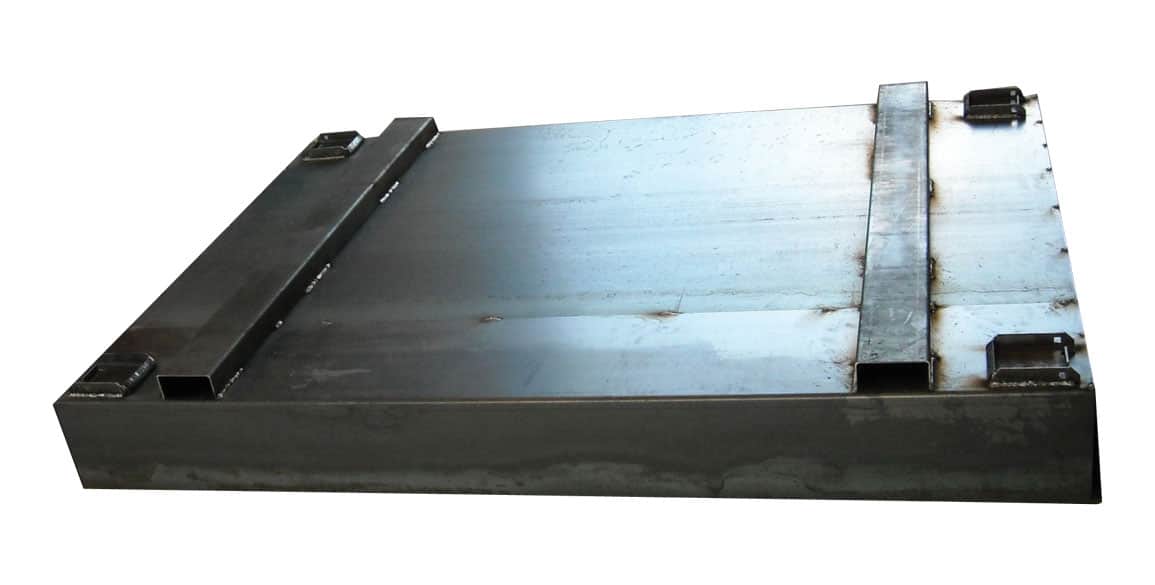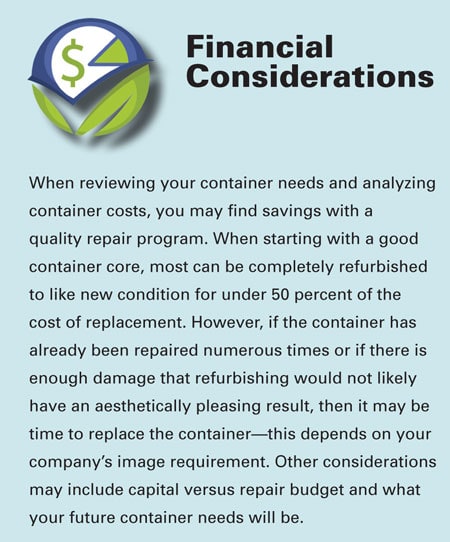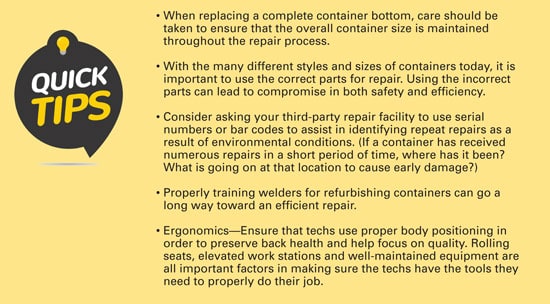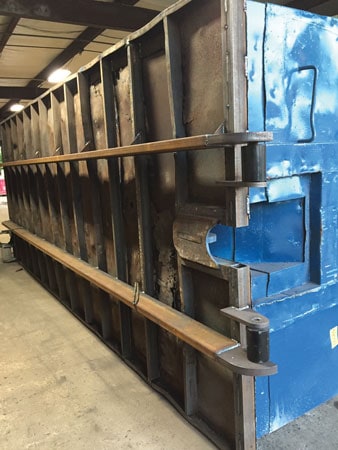By being pro-active with your container maintenance practices, you will increase the efficiency of your collection services, greatly reduce the inconvenience of container issues and maintain your company’s image.
By Gregg Roesch
Bucket type receptacles, or “dumpsters” have been in use since the mid-1930s and have become a major part of the collection process in our industry. Front end load, rear end load, self-contained compactors, receiver boxes and R/O containers are everywhere. When not maintained, containers can become a time-consuming headache to your daily operations. The life of a container can vary widely and be affected by a variety of factors including environmental conditions, initial container quality and container use.
Driver training and/or truck maintenance can also have an effect. Front load containers can be slammed down to the point of the wheels and channels being pushed through the bottom. Side guide roller damage on roll-off trucks can cause rail damage. Customers can also expose containers to unnecessary abuse by moving them around with heavy equipment or improperly loading heavy objects into them. Sometimes even the acids from beverage containers and glass from recycled containers can have an effect on container life.

Repair or Replace? Determining Factors
The need for a container to be repaired or replaced may originate from driver evaluations or write-ups, customer complaints or yard evaluations. Regular inspections can catch issues early and may prevent further and more extensive damage. Factors may include the lead time on new containers, and the condition of your cores. Are your container cores structurally sound? Are they straight and in generally good condition other than holes, lids and paint?
In some situations, todays advancements in container design, materials, coatings and covers can make replacement a sensible solution. Making the right decision can have a huge impact on the bottom line and also on the company’s image.


The Benefits of Outsourcing Repairs
When it comes time for containers to be repaired, consider using a third-party repair service rather than making the repairs in-house. Third-party repair companies also allows haulers to focus on their business of collection and processing. Sometimes, tasking a maintenance technician, routing manager or specialty personnel with managing the container repair process, which is not in his/her specialty or interest, can have negative effects on their primary tasks.
 Using third-party repair, which is focused solely on the business of repairing containers, will often result in a better finished product as well as being faster and cheaper. Some repair facilities will even provide transportation for trailer loads of containers to and from their facility for repair without cost to the hauler. In general, loads of containers can be returned in one to two weeks, ready for service.
Using third-party repair, which is focused solely on the business of repairing containers, will often result in a better finished product as well as being faster and cheaper. Some repair facilities will even provide transportation for trailer loads of containers to and from their facility for repair without cost to the hauler. In general, loads of containers can be returned in one to two weeks, ready for service.

Third-party repair facilities usually maintain a large inventory of parts, and also have the equipment and personnel to efficiently custom make parts that are uncommon. Casters, nose/ground rollers, lids, lid rods, paint, sheet steel, channel, tubing and decals are purchased in bulk and sometimes even container quantities resulting in better pricing and consistent availability. Lids, casters, locking devices and decals may also be installed by third party vendors, further simplifying the process.

Third-party repair can also help to streamline the hauler’s container inventory management processes and may also reduce the number of spare containers needed at a hauler’s site. In addition, outsourcing to a third-party repair facility will prevent the hauler from having to invest in additional welding and cutting tools, welding supplies, fork lifts and other specialty equipment.
In some situations, it is beneficial to use a combination of in-house and a third-party vendor; while the in-house maintenance team focuses on quick repairs which get containers back in use without excessive handling, the third-party company can be used for larger, more time-consuming repairs. If a hauler decides to do all repairs in-house, they would most-likely benefit from purchasing pre-fabricated bottoms and/or part kits to them help simplify their repairs.
Final Product
A properly made repair decision should not only result in a visually pleasing container but will also provide the same life expectancy as new. By being pro-active with your container maintenance practices, you will increase the efficiency of your collection services, greatly reduce the inconvenience of container issues and maintain your company’s image. | WA
